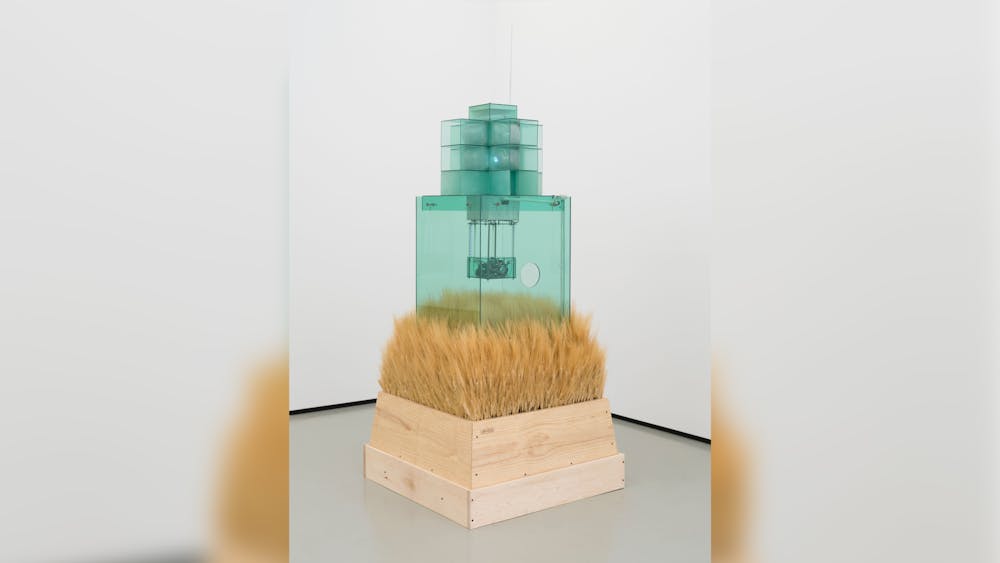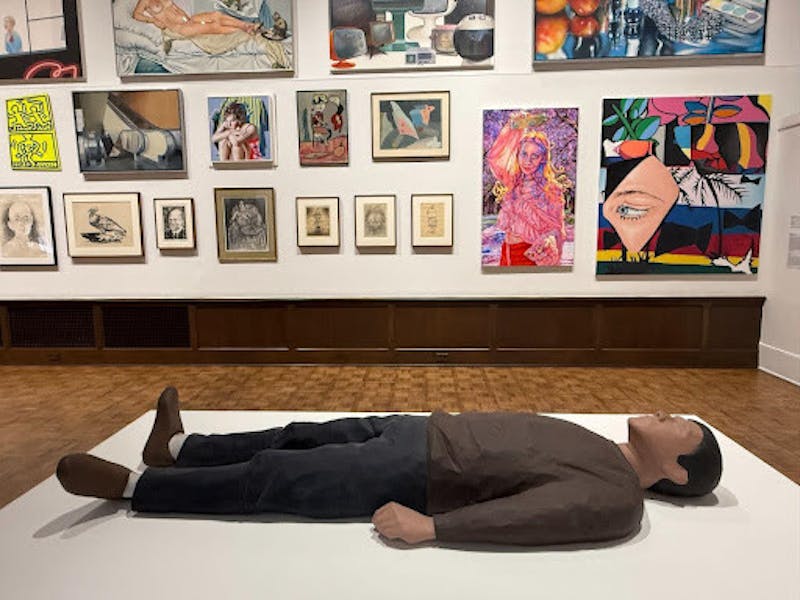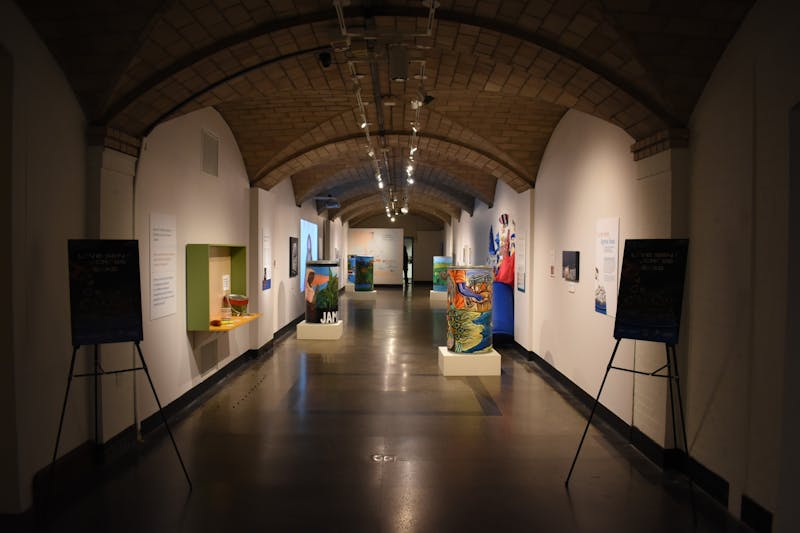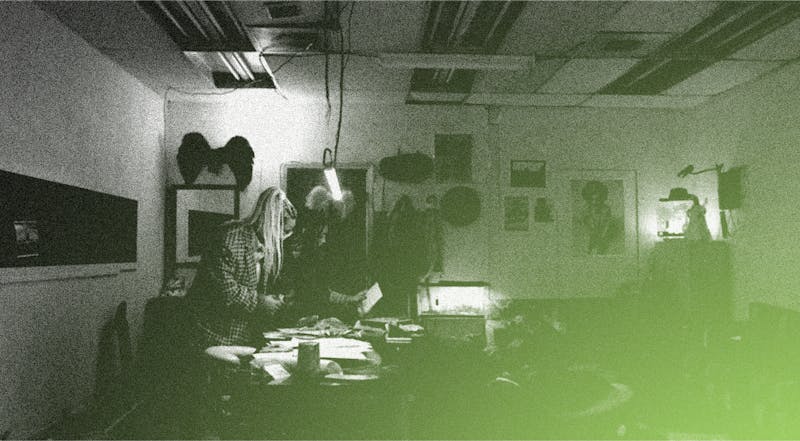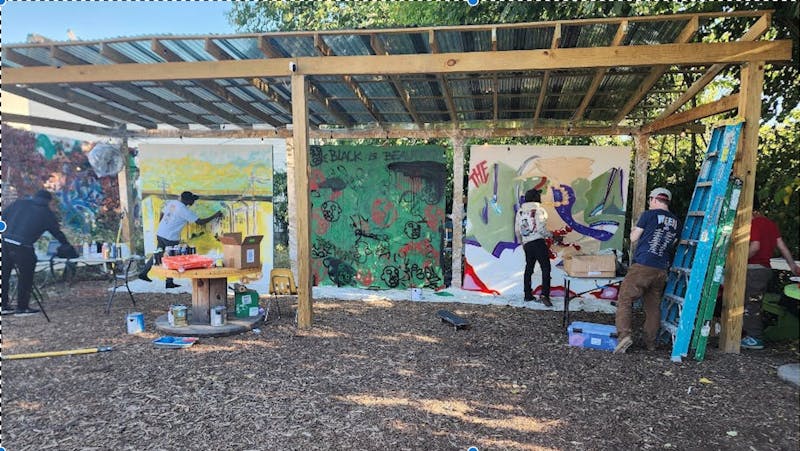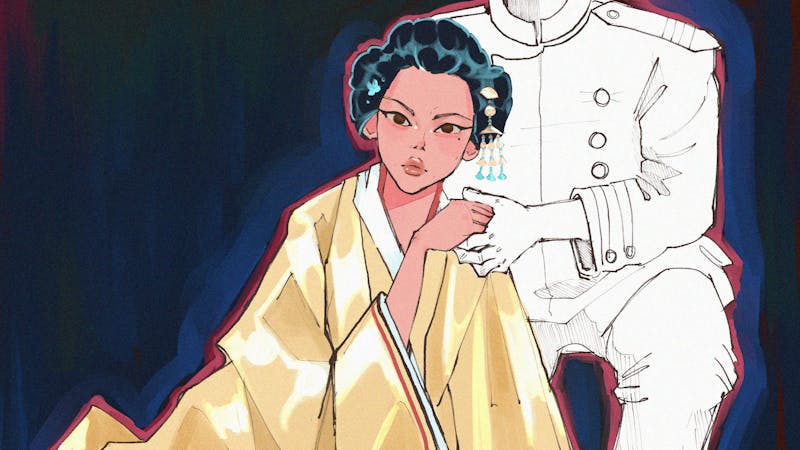The beautiful marvel of the Institute of Contemporary Art is its dynamic, flexible space that transforms with each fresh season. The new spring exhibition brings the essence of a laboratory, playground, and open field to both floors of its gallery. Carl Cheng’s exhibition Nature Never Loses opened Jan. 17, a Friday evening of jovial buoyancy and a bright exchange of energy between the gallery’s walls and its guests.
Nature Never Loses is a walk through the six decades of work by Cheng. Deeply concerned with the essence of the Anthropocene and the ever–present climate crisis, Cheng’s body of work plays with machinery, tools, product, and nature. His “art tools” and sculptural objects archive humanity’s interface with Earth and the evolution (or rather, erosion) that has become characteristic of the industrial epoch.
At the entrance, we are greeted by Anthropocene Landscape 1 and Anthropocene Landscape 2: a pair of grassy landscapes, as if we are looking out the window of a plane crossing over farmland made by a collage of printed circuit boards on aluminum. The whimsical visual contrast of Earth and technology introduces us to the “generosity, irreverence, and playfulness” that is imbued in the collection. The linear edges of the circuit boards reflect society’s logical thinking, and its resemblance to agricultural fields is a visual metaphor for humanity’s footprint on the earth. This theme—of humanity as ecosystem—is a common thread throughout the gallery.
We move to the first section of the exhibition: “Photography as a Tool.” As a primarily 2D section, Cheng’s ideology and thoughts are laid bare in the process of photography itself; our subjects are extracted from their habitations and create new meaning in themselves.
The next leg of the exhibition is titled “Natural Processes and Nature Machines.” Cheng works with organic materials and natural processes of life to subvert the concept of artistic authorship, in both process and artifact. Striking examples are his two works, Erosion Machine No. 4 and Erosion Machine No. 1, where fluorescent industrial boxes encase the erosion of “human rocks”—plaster mounds made up of everyday items. The current geological era has been characterized by climate change, loss of biodiversity, and human interference, and the Erosion Machines are at the intersection of artistic invention and the idea of the Anthropocene. Cheng’s foresight and innovative sense is apparent: The discovery of the “plastistones”—sedimentary rocks of minerals and plastic— was recorded in 2023. The progressive erosion is achieved with the continuous stream of water and illuminated with neon colors. The title of the section itself touches upon this interwoven nature of earth and people, where the line between humanity and nature becomes harder and harder to separate
John Doe Co., a later movement of the survey, encompasses Cheng’s critique of the function of products and a peek into his background in industrial design. The section’s title is also the name of Cheng’s production company; the use of ‘John Doe’ suggests the aim of revisiting the racial tensions in the US during the Vietnam War by parodying the label of the stereotypical white American army man. The inventions are like everything you’d find in a factory, appearing not so different from an air conditioner or vinyl plastic box at first. But they are also like nothing else you’d find commercially; the pieces move in response to the sound of the move, or include live material like wheat into its construction itself. Early Warning System is composed of plastic, LED lighting, but also a radio tuned to local stations and a wheat adorned wooden base. The works in this section are notably the most playful and visually engage the audience to investigate the ways that product can be art.
In his “Art Tools” section, Cheng experiments with painting tools in his series of Art Tool Paint Experiments, where kitschy–shaped wooden constructions are made to drag, dip, or pour paint within its abilities as an art sculpture, storage system, and tool. In Liquid/Solid Series, Cheng aggregates a grid of “microbes” with paint in droppers and pipettes. These pieces embrace new possibilities of art creation and apply the progressive arc of technology onto more commonly traditional art tools. The section also bleeds into Cheng’s work in public art, highlighting a coin–operated console and small awning of an anonymous public museum, which found a home on the Santa Monica Pier. The boundary between invention and art with nature and human blends into one another in these pieces and the entirety of his work.
The finale of the exhibition is Human Landscapes, tucked in the back corner of the upper level of the museum. Created with a large, patterned wheel rolled over a sandpile, the work is a map of figurative shapes and movements. It’s equal parts beach and relief sculpture, subsisting itself on the idea of impermanence. This work is definitively public, inviting the audience to walk along its perimeter and feel the impermanence in the brief encounter of the work. Once the exhibition closes, this exact work will only exist again in reproduction.
Nature Never Loses aims to complete its national tour in Los Angeles at the city’s ICA location—it was Cheng’s connection to Los Angeles that inspired much of his observations on people and nature. In the wake of the Los Angeles fires, many may feel a disconnect with Cheng’s message and staunch insistence that humanity cannot triumph over nature. But might Cheng’s work actually be prescient on the ways that natural forces will end up eclipsing life as we know it, rather than claiming our existence on earth is harmonious or friendly? Does Cheng’s work express hope for successful cohabitation, or is it a foreboding archive of life before disaster?
